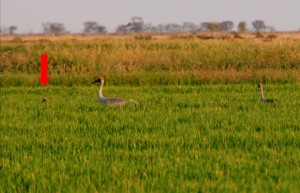It’s a rare event. I’d heard about it but until the beginning of this year I hadn’t seen it for myself. There they were – a pair of Brolgas that had bred in a rice crop. The landholders were delighted, as was I. In the New South Wales Riverina, the 2012-2013 season amounted to more than 100,000 hectares of rice. And that amount isn’t unusual outside of drought.
So why don’t Brolgas breed in rice crops more often? By the time there’s sufficient material to build a nest (late November – early December), it might be too late in their season. Is there a lack of tubers from native waterplants like Eleocharis spike-rushes that they love to eat? Maybe they breed in rice crops more than we realise. Can we encourage Brolgas to make better use of these agricultural wetlands? So many questions, so much work to do!
The Bitterns in Rice project, a collaboration between Birdlife Australia, the Rice Growers’ Association of Australia and other organisations, is developing rice-growing guidelines that will benefit the globally endangered Australasian Bittern. Along the way, we hope to incorporate the conservation of Brolgas and other threatened waterbirds like the Australian Painted Snipe.
This short article first appeared on the OzCranes website.


